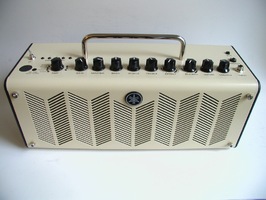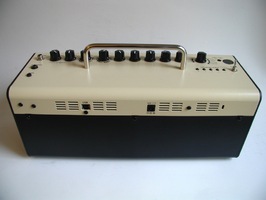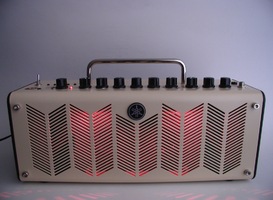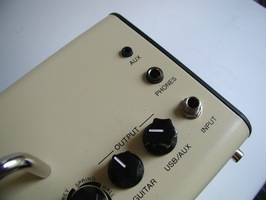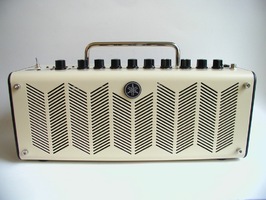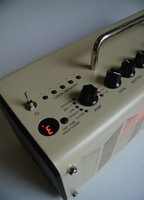Yamaha's new amplifier range now includes a brand new product: the THR10. It looks like a standard compact amp head. But in fact, this product holds some surprises...
It weights 6.2 lb and has the following dimensions: 14.2" × 7.2" × 5.5". Its cream finish and metal housing with vintage-style knobs give the THR10 an old-school touch although the amp design is definitely modern. The effects hosted in this small amp are based on Yamaha’s VCM modeling technology (Virtual Circuitry Modeling) you’ll find in many other products of the brand. The goal of this technology is to reproduce the behavior of old analog circuits to produce a classic warm sound.
The sleek design of this amp is ideal for musicians who are looking for a simple but effective tool.
Baby let’s play house!
The amp is provided with an external 100/240V (50/60Hz) power supply and some accessories including a comprehensive product manual with lots of images, a USB2 cable to connect to a Mac/PC, and a stereo minijack in/out to connect the amp to a recorder (MD, MP3, etc.). If you want to record your guitar with your Mac/PC, Steinberg’s sequencer Cubase Al is provided for free on the DVD-ROM.
The rear panel of the THR10 includes a DC IN connector for the external PSU and a USB port to communicate with your computer. Later on we’ll tell you about the settings provided by the THR interface. The front panel is a perforated metal grill with stripes that protects two 5-watt speakers. So the “head” can be used alone without the need of an additional speaker. Sweet! The four screws on the front panel contribute to the sleek and classy look of the amp. All settings and tuner LEDs are placed in front of the handle, making access to all features of this small sound machine easier.
Setting up the THR10 is almost “plug and play.” After powering on the device, a soft orange light (recalling the lights of tubes in standard amps) shines through the stripes of the perforated grill. The amp is equipped with Yamaha’s new “Extended Stereo Technology, ” which offers a wider stereo image by simulating a greater separation between both speakers. This feature can be disabled with the TAP/TUNER key.
My Amp is rich!
Plug your guitar into the INPUT connector, which seems sturdy and is firmly fixed to the housing. Select your amp from the five models available (Modern, Brit Hi, Lead, Crunch, or Clean). An LED indicates your selection. Adjust the GAIN and the MASTER levels. Finally, fine-tune your sound with the 3-band EQ (bass, middle, treble). The GUITAR OUTPUT knob controls the output volume of the speaker.
Besides electric guitar, the THR10 provides you with three other types of amplification:
- BASS: for bass guitar, as the name implies.
- ACO: the acoustic guitar option is certainly practical, but its sound is not very convincing. This is due to the small internal speakers, which are not able to reproduce all frequencies of an electro-acoustic guitar. The consequence is a dull, flat and dead sound.
- FLAT: for other sources, for example a keyboard or an iPod.
Both GAIN and MASTER controls work like on a classic amp. GAIN controls the gain of the preamp stage and the distortion amount, while MASTER sets the level of the power amp stage.
In clean mode, the tone is clear, rich and not harsh thanks to the very smooth high frequencies. This typical American sound is crystal-clear and resonant, very close to the typical Fender sound.
The crunch mode is definitely made for rock music, simulating British class-A all-tube amps, like the Vox AC30. The tone is bright, powerful and very dynamic. The twangy sound of open chords immediately brings to mind Brit Pop productions of the early 60's.
The Lead mode provides you with a warm and round sound with rich harmonics.
In Brit Hi mode, you get a powerful distortion for massive rhythm parts. The sound recalls a Marshall JCM 800.
Finally, the Modern mode produces a very high gain sound. You get a nice compression similar to that of Mesa Boogie amps. This mode is perfect for metal, hard rock and nu-metal, as well as for shredders.
All sound samples were recorded with a Gretsch Electromatic G-5129. The electro-acoustic guitar is a Gibson J-45 with its original transducer.
Generally speaking, the sound is very good considering the size of the amp. The low-frequency response is rather weak because of the size of the speakers, but the size/volume ratio is impressive. With some models, the Bass control is not very effective.

- position clean00:22
- position clean flanger00:27
- position crunch00:22
- position brit hi00:25
- lead british blues combo00:20
- position lead reverb00:22
- position aco00:34
After selecting the amp, you can add up to four effects to your sound: chorus, flanger, phaser and tremolo, adjustable using the EFFECT control. You also get four delay and reverb effects you can adjust with the DLY/REV control.
This amp is not small enough to fit inside your guitar bag, but it is still pretty compact. With its small chrome handle, you can take it anywhere with you. The amp is a great solution to play backstage before a gig or at home without disturbing your neighbors.
The integrated tuner is practical and accurate. To access/quit the tuner, just press the TAP/TUNER key and hold it for a few seconds. As soon as the tuner is turned on, the loudspeakers and the headphones are muted. Tuning you guitar is very easy thanks to the small LED display whose red LEDs indicate that the note is either too high or too low; a green LED lights up when the string is in tune.
The THR10's dual operation system allows you to use it at home or on the road since it also works with eight LR6 batteries.
Connection to a computer
Here are Yamaha’s system requirements if you want to use the THR10 with your computer optimally: Windows 7 (32 or 64 bit) or Mac OS X 10, minimum 2 GB RAM, Intel or Dual Core CPU, 1280×800 screen resolution.
The connection between the THR10 and your computer allows you to do three different things:
- In your computer, you can read audio files that are played back by the THR10
- You can edit the amp settings using the THR interface.
- You can record the audio signal using, for example, Cubase Al 6, which is provided with the amp.
After downloading the plug-in and the THR application (available on Yamaha’s website for free), the installation is easy and fast. Just follow the on-screen instructions. After that, you’ll have to install Cubase.
Once Cubase, the driver and the THR interface are installed, you can connect the THR10 to the computer using the USB cable provided. When connected, the OUTPUT USB/AUX control on the THR10 is used to set the volume. Cubase automatically recognizes the THR10… and the amp is ready to be used. In this case, the amp acts like a digital audio interface and you can access all amp settings on your computer screen very easily. The THR editor is very intuitive. It allows you to shape and change the sound adjusting its tonality, gain, effects, etc. The THR window also provides you with a compressor and a noise gate, editable only via the software interface. The THR allows you to save your settings to your hard drive and to transfer them to the amp as well. To do this, just hold down the USER MEMORY button of the selected memory bank for several seconds. You can store up to five settings. You can also download a preset bank from Yamaha’s website, and store it into the THR10. Nice and convenient!
Conclusion
This small amp surprised us with its compact size and good sound quality. The THR10 meets the needs of both beginners and experienced guitar players looking for a small practice amp. Thanks to its design and sturdiness, you can use this amp at home or even outdoors with batteries. We couldn’t test the battery runtime but the manufacturer states an estimate of 6–7 hours of operation. The price is a bit high, but the product is really appealing.

